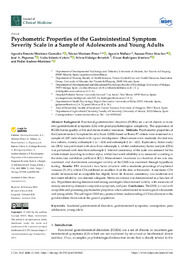Por favor, use este identificador para citar o enlazar este ítem:
https://hdl.handle.net/11000/36092Registro completo de metadatos
| Campo DC | Valor | Lengua/Idioma |
|---|---|---|
| dc.contributor.author | Martínez-González, Agustín Ernesto | - |
| dc.contributor.author | Montoro-Pérez, Néstor | - |
| dc.contributor.author | Wallace, Agustín | - |
| dc.contributor.author | Pérez-Sánchez, Susana | - |
| dc.contributor.author | Piqueras, Jose A | - |
| dc.contributor.other | Departamentos de la UMH::Psicología de la Salud | es_ES |
| dc.date.accessioned | 2025-03-24T12:17:57Z | - |
| dc.date.available | 2025-03-24T12:17:57Z | - |
| dc.date.created | 2024 | - |
| dc.identifier.citation | Journal of Clinical Medicine 2024, 13, 1662 | es_ES |
| dc.identifier.issn | 2077-0383 | - |
| dc.identifier.uri | https://hdl.handle.net/11000/36092 | - |
| dc.description.abstract | Abstract: Background: Functional gastrointestinal disorders (FGIDs) are a set of chronic or recur- rent gastrointestinal symptoms (GS) with great psychobiological complexity. The appearance of FGIDs harms quality of life and drains medical resources. Methods: Psychometric properties of the Gastrointestinal Symptom Severity Scale (GSSS) based on Rome IV criteria were examined in a sample of 1247 individuals with typical development. Observations were randomly divided into two subsets, namely, subsample 1 (n = 624) and subsample 2 (n = 623). Exploratory factor analy- sis (EFA) was performed with data from subsample 1, whilst confirmatory factor analysis (CFA) was performed with data from subsample 2. Internal consistency of the scale was assessed for the whole dataset according to ordinal alpha, whilst four-week reliability was measured according to the intraclass correlation coefficient (ICC). Measurement invariance as a function of sex was also examined, and discriminant–convergent validity of the GSSS was examined through hypothesis testing. Results: EFA revealed a two-factor structure with a moderate percentage of explained variance (51.3%), whilst CFA exhibited an excellent fit of the data to the model. A one-factor CFA model demonstrated an acceptable but slightly lower fit. Internal consistency was moderate and test–retest reliability was deemed adequate. Metric invariance was demonstrated as a function of sex. Hypothesis testing demonstrated strong convergent–discriminant validity with measures of sensory sensitivity, obsessive–compulsive symptoms, and pain. Conclusions: The GSSS is a tool with acceptable and promising psychometric properties when administered to neurotypical adolescents and young adults. The self-report GSSS may promote better understanding of GS involvement in the gut microbiota–brain axis in the general population. | es_ES |
| dc.format | application/pdf | es_ES |
| dc.format.extent | 13 | es_ES |
| dc.language.iso | eng | es_ES |
| dc.publisher | MDPI | es_ES |
| dc.rights | info:eu-repo/semantics/openAccess | es_ES |
| dc.rights | Attribution-NonCommercial-NoDerivatives 4.0 Internacional | * |
| dc.rights.uri | http://creativecommons.org/licenses/by-nc-nd/4.0/ | * |
| dc.subject | functional gastrointestinal disorders | es_ES |
| dc.subject | constipation | es_ES |
| dc.subject | pain | es_ES |
| dc.subject | gastrointestinal symptoms | es_ES |
| dc.subject | adolescents | es_ES |
| dc.subject | young adults | es_ES |
| dc.subject.other | CDU::1 - Filosofía y psicología::159.9 - Psicología | es_ES |
| dc.title | Psychometric Properties of the Gastrointestinal Symptom Severity Scale in a Sample of Adolescents and Young Adults | es_ES |
| dc.type | info:eu-repo/semantics/article | es_ES |
| dc.relation.publisherversion | https://doi.org/10.3390/jcm13061662 | es_ES |

Ver/Abrir:
2024_Jcm-2024_13-02024_1662-v2 (2).pdf
897,44 kB
Adobe PDF
Compartir:
 La licencia se describe como: Atribución-NonComercial-NoDerivada 4.0 Internacional.
La licencia se describe como: Atribución-NonComercial-NoDerivada 4.0 Internacional.
.png)